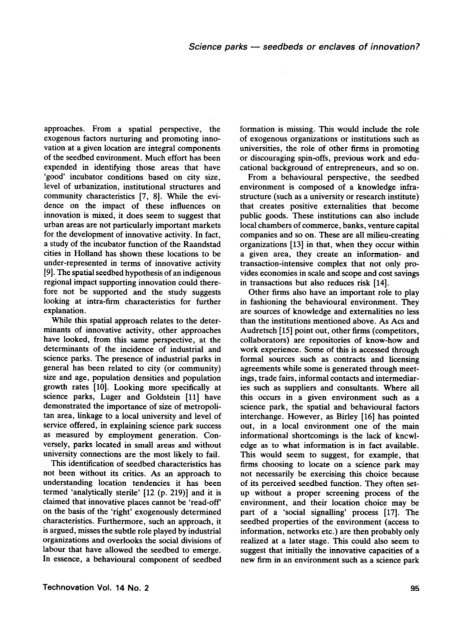University-related science parks - 'seedbeds' or 'enclaves' of ...
University-related science parks - 'seedbeds' or 'enclaves' of ...
University-related science parks - 'seedbeds' or 'enclaves' of ...
You also want an ePaper? Increase the reach of your titles
YUMPU automatically turns print PDFs into web optimized ePapers that Google loves.
Science <strong>parks</strong> - seedbeds <strong>or</strong> enclaves <strong>of</strong> innovation?approaches. From a spatial perspective, theexogenous fact<strong>or</strong>s nurturing and promoting innovationat a given location are integral components<strong>of</strong> the seedbed environment. Much eff<strong>or</strong>t has beenexpended in identifying those areas that have‘good’ incubat<strong>or</strong> conditions based on city size,level <strong>of</strong> urbanization, institutional structures andcommunity characteristics [7, 81. While the evidenceon the impact <strong>of</strong> these influences oninnovation is mixed, it does seem to suggest thaturban areas are not particularly imp<strong>or</strong>tant marketsf<strong>or</strong> the development <strong>of</strong> innovative activity. In fact,a study <strong>of</strong> the incubat<strong>or</strong> function <strong>of</strong> the Raandstadcities in Holland has shown these locations to beunder-represented in terms <strong>of</strong> innovative activity[9]. The spatial seedbed hypothesis <strong>of</strong> an indigenousregional impact supp<strong>or</strong>ting innovation could theref<strong>or</strong>enot be supp<strong>or</strong>ted and the study suggestslooking at intra-firm characteristics f<strong>or</strong> furtherexplanation.While this spatial approach relates to the determinants<strong>of</strong> innovative activity, other approacheshave looked, from this same perspective, at thedeterminants <strong>of</strong> the incidence <strong>of</strong> industrial and<strong>science</strong> <strong>parks</strong>. The presence <strong>of</strong> industrial <strong>parks</strong> ingeneral has been <strong>related</strong> to city (<strong>or</strong> community)size and age, population densities and populationgrowth rates [lo]. Looking m<strong>or</strong>e specifically at<strong>science</strong> <strong>parks</strong>, Luger and Goldstein [ll] havedemonstrated the imp<strong>or</strong>tance <strong>of</strong> size <strong>of</strong> metropolitanarea, linkage to a local university and level <strong>of</strong>service <strong>of</strong>fered, in explaining <strong>science</strong> park successas measured by employment generation. Conversely,<strong>parks</strong> located in small areas and withoutuniversity connections are the most likely to fail.This identification <strong>of</strong> seedbed characteristics hasnot been without its critics. As an approach tounderstanding location tendencies it has beentermed ‘analytically sterile’ [12 (p. 219)] and it isclaimed that innovative places cannot be ‘read-<strong>of</strong>fon the basis <strong>of</strong> the ‘right’ exogenously determinedcharacteristics. Furtherm<strong>or</strong>e, such an approach, itis argued, misses the subtle role played by industrial<strong>or</strong>ganizations and overlooks the social divisions <strong>of</strong>labour that have allowed the seedbed to emerge.In essence, a behavioural component <strong>of</strong> seedbedf<strong>or</strong>mation is missing. This would include the role<strong>of</strong> exogenous <strong>or</strong>ganizations <strong>or</strong> institutions such asuniversities, the role <strong>of</strong> other firms in promoting<strong>or</strong> discouraging spin-<strong>of</strong>fs, previous w<strong>or</strong>k and educationalbackground <strong>of</strong> entrepreneurs, and so on.From a behavioural perspective, the seedbedenvironment is composed <strong>of</strong> a knowledge infrastructure(such as a university <strong>or</strong> research institute)that creates positive externalities that becomepublic goods. These institutions can also includelocal chambers <strong>of</strong> commerce, banks, venture capitalcompanies and so on. These are all milieu-creating<strong>or</strong>ganizations [13] in that, when they occur withina given area, they create an inf<strong>or</strong>mation- andtransaction-intensive complex that not only provideseconomies in scale and scope and cost savingsin transactions but also reduces risk [14].Other firms also have an imp<strong>or</strong>tant role to playin fashioning the behavioural environment. Theyare sources <strong>of</strong> knowledge and externalities no lessthan the institutions mentioned above. As Acs andAudretsch [15] point out, other firms (competit<strong>or</strong>s,collab<strong>or</strong>at<strong>or</strong>s) are reposit<strong>or</strong>ies <strong>of</strong> know-how andw<strong>or</strong>k experience. Some <strong>of</strong> this is accessed throughf<strong>or</strong>mal sources such as contracts and licensingagreements while some is generated through meetings,trade fairs, inf<strong>or</strong>mal contacts and intermediariessuch as suppliers and consultants. Where allthis occurs in a given environment such as a<strong>science</strong> park, the spatial and behavioural fact<strong>or</strong>sinterchange. However, as Birley [16] has pointedout, in a local environment one <strong>of</strong> the maininf<strong>or</strong>mational sh<strong>or</strong>tcomings is the lack <strong>of</strong> kncwledgeas to what inf<strong>or</strong>mation is in fact available.This would seem to suggest, f<strong>or</strong> example, thatfirms choosing to locate on a <strong>science</strong> park maynot necessarily be exercising this choice because<strong>of</strong> its perceived seedbed function. They <strong>of</strong>ten setupwithout a proper screening process <strong>of</strong> theenvironment, and their location choice may bepart <strong>of</strong> a ‘social signalling’ process [17]. Theseedbed properties <strong>of</strong> the environment (access toinf<strong>or</strong>mation, netw<strong>or</strong>ks etc.) are then probably onlyrealized at a later stage. This could also seem tosuggest that initially the innovative capacities <strong>of</strong> anew firm in an environment such as a <strong>science</strong> parkTechnovation Vol. 14 No. 2 95
















